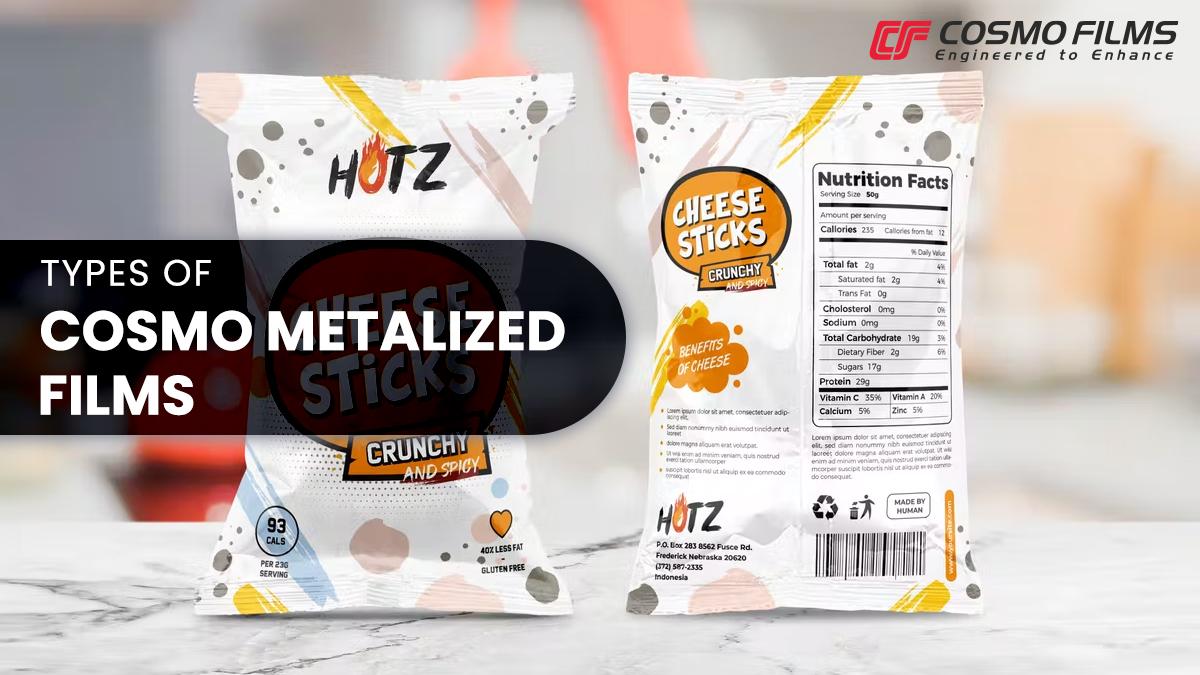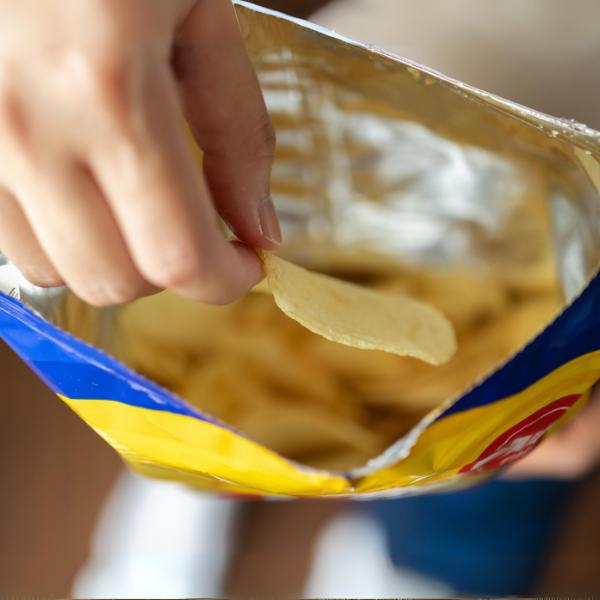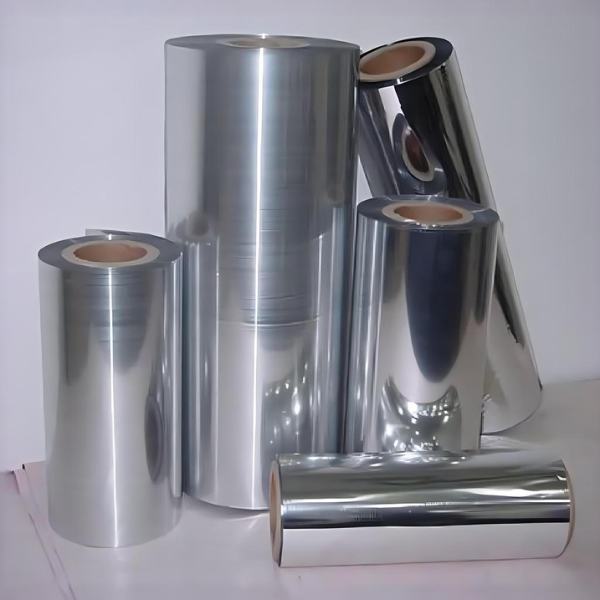How Do Metalized Films Enhance Food Shelf Life and Protect Contents?

Metalized films are plastic films coated with a very thin layer of aluminum. These films usually start with base materials like BOPP (biaxially oriented polypropylene), PET (polyethylene terephthalate), or PE (polyethylene). The aluminum coating is applied in a vacuum through a process called vapor deposition. This means aluminum atoms vaporize in a vacuum chamber and settle evenly on the plastic film, creating a shiny and reflective surface.
This thin metallic layer greatly enhances the film’s barrier properties. Here’s how it works:
- Blocks oxygen and moisture: Aluminum is almost impermeable to gases and water vapor. Even a thin layer can stop oxygen and moisture from passing through the packaging. This is key because oxygen causes food spoilage by reacting with fats and enzymes. Moisture can trigger mold growth or degrade crispy textures.
- Protects against light: Many foods, especially oils, fats, and vitamins, break down when exposed to light. The shiny metal layer reflects ultraviolet (UV) and visible light away, reducing photodegradation.
- Creates a controlled microenvironment: By blocking outside air and moisture, metalized films isolate the food inside. This slows chemical reactions and microbial growth that cause spoilage. Reduced exposure to air lowers oxidation, while limited moisture ingress reduces mold and bacteria risks.
Spoilage Mechanisms Metalized Films Help to Prevent
Metalized films target three main spoilage routes:
- Oxidation—Oxygen reacts with fats and vitamins, making food go rancid or lose nutrients.
- Moisture ingress—Humidity allows mold, bacteria, and texture changes.
- Photodegradation—Light breaks down sensitive food components like oils and vitamins.
By reducing these factors, metalized films slow food degradation and extend shelf life significantly.
Reflective and Thermal Insulation Properties
The reflective surface of metalized films also plays a surprising role in protecting food from heat damage. The aluminum layer reflects thermal radiation, helping keep the internal temperature more stable.
This thermal insulation is useful during transport and storage, when food can face temperature swings. It helps maintain freshness, texture, and safety longer. For example, snack foods or coffee sealed inside metalized films remain crisp and flavorful due to this added thermal protection.
Common Types of Metalized Films in Food Packaging
There are five popular metalized film types, each with unique uses:
| Film Type | Base Film | Key Features | Uses |
|---|---|---|---|
| Aluminum Foil (pure metal) | Pure aluminum sheet | Best barrier and insulation | High-end food, pharmaceuticals |
| Vacuum Metalized Film | Usually BOPP or PET | Uniform thin metal layer | Snacks, confectionery, coffee packs |
| Metallized Polypropylene | BOPP base | Strong, moisture resistant | Snack bags, sealed pouches |
| Metallized Polyester | PET base | High strength, high reflectivity | Food pouches, blister packs |
| Metallized Polyethylene | PE base | Cost-effective moisture barrier | Basic food packaging, liners |
Metalized Films Compared with EVOH and Aluminum Foil
Metalized films bridge the gap between heavier foils and advanced polymers like EVOH:
- Compared to EVOH: EVOH (ethylene vinyl alcohol) films have excellent gas barrier properties too, especially oxygen. But they are less effective against moisture and often need lamination. Metalized films combine moisture and oxygen barriers with light blocking, offering a broader shield. EVOH gives options for package transparency, while metalized films are opaque and metallic look.
- Compared to aluminum foil: Pure aluminum foil offers the highest barrier but is heavier and less flexible. Metalized films are lightweight and flexible, making them cheaper to produce and use less material. They also support high-quality printing for branding, unlike foil. Metalized films can match or even exceed foil barrier performance thanks to innovations in coating methods.
How Metalized Films Extend Food Shelf Life
By improving barrier properties, metalized films hold back oxygen, moisture, and light. This reduction in exposure slows:
- Chemical reactions like oxidation of fats and vitamins
- Microbial growth responsible for mold and spoilage
- Texture changes due to humidity or dehydration
- Loss of aroma and flavor compounds
The results are foods that stay fresh longer, taste better, and maintain safety without added preservatives. For example, snacks sealed in metalized bags remain crunchy for weeks, and vacuum coffee packs preserve aroma for months.
In short: Metalized films protect food by building a strong barrier against external spoilage agents. They create a stable environment that slows degradation, preserve nutritional quality, and maintain fresh texture and flavor. These strengths make metalized films a top choice in modern food packaging industries aimed at extending shelf life and reducing waste.
What Are the Practical Benefits and Applications of Metalized Films in Food Packaging?

When you discuss how metalized films enhance food shelf life and protect contents, it’s key to understand their practical benefits and applications. These films play a vital role in preserving food quality and safety while offering multiple packaging uses.
How Do Metalized Films Resist Moisture, Oxygen, and Contaminants?
Metalized films are plastic films coated with a very thin layer of aluminum using vacuum deposition. This aluminum layer acts like a shield. It blocks oxygen, moisture, and contaminants from reaching food. Oxygen causes oxidation, which spoils fats, oils, and vitamins. Moisture lets mold grow and ruins texture. Contaminants can spoil the taste or harm health.
The metal coating prevents gases and water vapor from passing through. This stops oxidation, moisture ingress, and photodegradation caused by light. These functions create a controlled microenvironment inside the packaging, slowing down spoilage and microbial growth. For example, snack foods last longer and stay crisp. Coffee packs protect aroma and freshness.
| Barrier to | Effect on Food |
|---|---|
| Oxygen | Prevents rancidity and spoilage |
| Moisture | Avoids mold and sogginess |
| Contaminants | Ensures hygiene and safety |
| UV Light | Protects oils from breaking down |
Packaging Formats That Use Metalized Films
Metalized films are very flexible in application. Here are some common packaging types that use these films:
- Heat-sealed bags: Perfect for chips, nuts, and candy. They lock in freshness.
- Pouches: Often resealable, used for dried fruits, supplements, or pet food.
- Snack bar wrappers: Offer moisture and oxygen barrier while showing off branding.
- Vacuum coffee packs: Preserve aroma and flavor for months.
- Blister packs: For pharmaceuticals and nutraceuticals needing long shelf life.
Because metalized films can be laminated or co-extruded, they fit into many machinery types like Horizontal Form Fill Seal (HFFS) and Vertical Form Fill Seal (VFFS), adapting to product needs and speeds.
How Metalized Films Improve Tamper Evidence and Product Safety
Metalized films heat seal very well. This means packages can be tightly closed. If a seal breaks, customers know immediately — ensuring tamper evidence. This feature is critical for food safety and consumer confidence.
The heat sealability also helps in making resealable pouches, keeping food safe after opening. Containers stay air- and moisture-tight, preventing spoilage.
Visual Appeal and Printing Advantages
Metalized films have a shiny, reflective surface. This makes printed graphics pop with bright, vivid colors. They support many printing types: flexography, UV, offset, and letterpress.
Brands use metalized films to create packaging with:
- Bold metallic colors: Like gold, silver, or copper.
- Geometric or futuristic patterns: To attract modern consumers.
- Natural or minimalistic designs: For eco-friendly branding.
The visual impact improves shelf visibility. Shiny packages catch the eye and make products look premium. This ties directly to stronger sales.
Lightweight Nature Reduces Shipping Costs and Environmental Impact
Compared to heavy materials like aluminum foil, metalized films are very light. They require less raw material while keeping excellent barrier properties. This means:
- Lower shipping weights cut freight costs.
- Reduced fuel use lowers carbon emissions.
- Less packaging waste if films are recyclable.
Lightweight packaging also reduces wear on machines during manufacturing, saving maintenance and energy.
Current Design Trends Combining Aesthetics with Functionality
In 2023, metalized films embrace several design trends, including:
- Metallic colors: Bright gold and silver dominate for a premium look.
- Geometric patterns: Add sophistication and tech appeal.
- Futuristic styles: Using metals for a cutting-edge feel.
- Organic motifs: Green themes for natural and safe image.
- Minimal fonts: For clean, elegant messaging.
These trends show that metalized films serve both function and beauty in packaging design.
Multilayer and Co-Extruded Films for Diverse Needs
To meet different protection levels, multilayer metalized films combine various materials:
- Base layers like BOPP or PET add strength and clarity.
- Metalized layers add barrier protection and reflectivity.
- Heat sealable layers ensure secure closing.
Co-extrusion means layers bond firmly, improving durability. Some multilayer films add white opaque layers for bright printing backgrounds or oxo-biodegradable layers for eco-safe disposal.
This versatility helps brands pick films specific to product needs, like moisture-sensitive snacks, oily supplements, or light-sensitive beverages.
Sector-Specific Examples of Metalized Film Use
Metalized films appear in many industries:
| Sector | Products | Benefits Utilized |
|---|---|---|
| Snacks | Potato chips, popcorn, nuts | Moisture & oxygen barrier, attractive shine |
| Cosmetics | Powder pouches, tubes | Tamper evidence, print quality, protection |
| Nutraceuticals | Vitamin sachets, protein bars | Long shelf life, contamination resistance |
| Beverages | Coffee bags, tea pouches | Aroma preservation, UV protection |
For example, vacuum coffee packs use metalized polypropylene films coated with aluminum. This preserves freshness for 6 months or more. Cosmetic powders use matte metalized laminates to combine barrier and elegance.
Key Benefits of Using Metalized Films for Food Packaging
To answer what benefits metalized films provide in food packaging, here’s a summary:
| Key Benefits | Details |
|---|---|
| Barrier Protection | Excellent against gases, moisture, and light |
| Heat Sealability | Ensures tamper-proof and resealable packaging |
| Print Quality | Supports high-quality visuals boosting branding and sales |
| Lightweight | Reduces transport costs and environmental impact |
| Design Flexibility | Multilayer and co-extrusion options for specific needs |
| Shelf Life Extension | Slows spoilage and maintains freshness |
| Packaging Formats | Suitable for bags, pouches, wrappers, and blister packs |
These advantages make metalized films a go-to for keeping food fresh, safe, and market-ready across the globe.
What Limitations, Considerations, and Future Trends Should Be Known About Metalized Films in Food Shelf Life Extension?

When we discuss how metalized films enhance food shelf life and protect contents, it's vital to understand their limitations and the factors that affect their performance. Metalized films are excellent at blocking oxygen, moisture, and light, yet they are not perfect for every food or packaging type. Let's dig deeper into what you should know about these films, their challenges, and what the future holds.
Limitations of Metalized Films in Extending Shelf Life
Metalized films are a strong barrier against oxygen and moisture, but some limits exist, especially with perishable foods. For example:
- Not a Cure-All for Fresh Foods: While metalized films slow down spoilage by blocking oxygen and moisture, they can't stop natural decay in highly perishable items like fresh berries or leafy greens.
- Limited Gas Barrier for Certain Foods: Some products need specific gas permeability (e.g., modified atmosphere packaging). Metalized films may be too impermeable, causing anaerobic spoilage or off-flavors.
- Susceptible to Physical Damage: Thin metalized layers can scratch or crack during handling, reducing their barrier effectiveness.
- Sensitivity to Heat and Humidity: High temperatures during sealing or storage can degrade the metallic coating, causing barrier loss or adhesion problems.
Influence of Product Type and Packaging Format
The choice of metalized film depends heavily on what you are packing and how. Different food types and formats need specific properties:
- Snack Foods and Dry Products: They benefit most from metalized polypropylene (PP) or polyethylene terephthalate (PET) films, known for moisture resistance and mechanical strength.
- Oily or Moisture-Rich Products: Metallized polyester films give better oil resistance, preventing grease migration.
- Flexible Pouches and Heat-Sealed Bags: Films with strong heat sealability and uniform metallic coating, like vacuum metallized films, are preferred.
- Rigid or Vacuum Packaging: More advanced laminates combining metalized films with EVOH or aluminum foil improve both barrier and structural integrity.
Packaging formats like stand-up pouches, pillow bags, and snack wrappers dictate the required mechanical properties and sealing compatibility of metalized films. So, it’s not a one-size-fits-all; you must match product needs with the right film type.
Emerging Sustainable and Recyclable Metalized Film Options
Sustainability drives today's packaging decisions. Metalized films have faced criticism for being challenging to recycle, but progress is promising:
- Mono-material Metalized Films: These films use a single polymer base, such as all-PP or all-PE, metalized with aluminum. This design simplifies recycling streams because no multi-layer lamination is involved.
- Oxo-biodegradable Coatings: Some metalized films come with oxo-biodegradable layers to reduce environmental impact after disposal.
- Solvent-Free Coating Technologies: Innovations reduce the use of harmful chemicals in film production, making the films safer for the environment.
- Lightweight and Less Material Use: Since metalized films offer strong barriers with thinner layers compared to foil laminates, they reduce raw material needs significantly.
According to current market research, sustainable metalized films are set to capture a growing share of food packaging, driven by consumer demand and regulations.
How Mono-Material Metalized Films Improve Recyclability
Traditional metalized films are multi-layer composites that complicate recycling. Mono-material solutions are changing this scenario:
| Feature | Mono-Material Metalized Films | Conventional Multi-Layer Films |
|---|---|---|
| Polymer Base | Single type (e.g., polypropylene only) | Multiple materials laminated |
| Recycling Process | Compatible with standard plastic recycling | Difficult, often sent to landfills |
| Barrier Properties | Comparable to multi-layer films with new tech | High barrier but less recyclable |
| Environmental Impact | Lower due to easier recycling | Higher due to complexity of disposal |
Mono-material films maintain moisture, oxygen, and light barriers close to multi-layer films while enabling better recyclability, which helps companies meet circular economy goals.
Technical Challenges in Metallization and Compatibility
While metalized films offer many benefits, some technical hurdles remain:
- Adhesion Issues: The aluminum layer must firmly stick to the plastic film. Inconsistent adhesion can cause flakes or loss of barrier properties.
- Print Compatibility: Metal surfaces can be tricky for printing inks. Special coatings or primers may be needed to achieve good ink adhesion for logos or branding.
- Machine Compatibility: Packaging machines like Horizontal Form Fill Seal (HFFS) and Vertical Form Fill Seal (VFFS) require films with consistent thickness and properties for smooth operation. Variances in metalized film quality can cause jams or wasted packages.
- Heat Seal Challenges: Metalized films sometimes need co-extruded layers to optimize heat sealing without damaging the metal layer.
Addressing these challenges often means working closely with experienced suppliers who provide customized film options adjusted to each product’s needs and packaging equipment.
Customization and Supplier Role in Metalized Film Selection
Selecting the right metalized film isn’t just about picking from standard options. Suppliers play a crucial role by:
- Offering Tailored Barrier Levels: Depending on the food's sensitivity, suppliers can help customize moisture, oxygen, and light barrier requirements.
- Providing Technical Support: From film testing to advice on print compatibility and seal strength.
- Ensuring Quality Consistency: High-quality films reduce production downtime and improve shelf life reliability.
- Supporting Sustainable Goals: Suppliers often have eco-friendly metalized films aligning with brand sustainability commitments.
For example, a beverage brand using metalized wrap-around label films benefits from supplier expertise in achieving both high optical density and stiffness needed for mold resistance and shelf appeal.
Evolution of the Metalized Packaging Market and Trends in India
India’s metalized packaging market is booming, with a projected CAGR of 26.7% over the next five years. This growth is fueled by:
- Rising Consumer Demand: Increased awareness of food safety prompts packaging adopting strong barrier solutions.
- Changing Lifestyles: Ready-to-eat, snacks, and processed foods require packaging that extends freshness.
- Government Regulations: New packaging laws emphasize safety and sustainability, pushing demand for recyclable metalized films.
- Local Manufacturing Innovations: Indian suppliers are improving local metalized film production to reduce imports and costs.
This trend indicates a robust future for metalized films, especially with innovations integrating sustainability and high functionality.
Innovations in Metalized Film Production and Applications
Looking ahead, several innovations will enhance metalized films for food shelf life and protection:
| Innovation | Description | Benefit |
|---|---|---|
| High-Bond Metallization | Improves aluminum adhesion to film | Increased durability and barrier under harsh conditions |
| Co-Extruded Mono-Material Laminates | Combines barrier and heat seal layers in one polymer | Easier recycling and strong sealing |
| Smart Packaging Integration | Embeds sensors or freshness indicators | Real-time product quality monitoring |
| Advanced Printing Technologies | UV and water-based inks compatible with metal surfaces | Vibrant, sustainable packaging visuals |
| Barrier Film Rationalization | Multi-layer laminates replacing complex structures | Maintains performance while reducing raw material use |
These advancements will help metalized films maintain their edge as a key player in food protection and shelf life extension while meeting evolving sustainability needs.
Understanding these factors will help anyone choosing or working with metalized films for food packaging. Despite some limitations, their strengths combined with innovation and sustainable options make metalized films a versatile solution to keep food fresher longer while protecting contents from harm.

FAQs about Discuss how metalized films enhance food shelf life and protect contents:
What is the basic mechanism of how metalized films enhance food shelf life and protect contents?
The basic mechanism of how metalized films enhance food shelf life and protect contents is by using a thin aluminum layer coated on plastic films to block oxygen, moisture, and light, thus creating a controlled microenvironment that slows oxidation, microbial growth, and photodegradation.
How do metalized films resist moisture, oxygen, and contaminants?
Metalized films resist moisture, oxygen, and contaminants by applying a vacuum-deposited aluminum layer that acts as a barrier, preventing gases, water vapor, and impurities from reaching the food and causing spoilage or degradation.
What are the practical applications and packaging formats that use metalized films?
Practical applications and packaging formats that use metalized films include heat-sealed bags for snacks, resealable pouches, snack bar wrappers, vacuum coffee packs, and blister packs, enabling freshness retention and product safety across diverse food and pharmaceutical products.
What limitations and considerations should be known about metalized films in extending food shelf life?
Limitations and considerations about metalized films in extending food shelf life include their inability to stop all spoilage in highly perishable foods, susceptibility to physical damage, sensitivity to heat and humidity during processing, and the need to match film properties carefully to specific product and packaging requirements.
How do future trends and sustainability efforts impact metalized film development
Metalized films boost food shelf life by blocking oxygen, moisture, and light. Their thin aluminum layer stops spoilage and keeps food fresh longer. These films also help with heat sealing, product safety, and brand design. Yet, they have limits, especially with fresh foods, and face recycling challenges. New trends focus on better sustainability and tailored solutions. Understanding how metalized films work helps you pick the best packaging to protect food and reduce waste.

